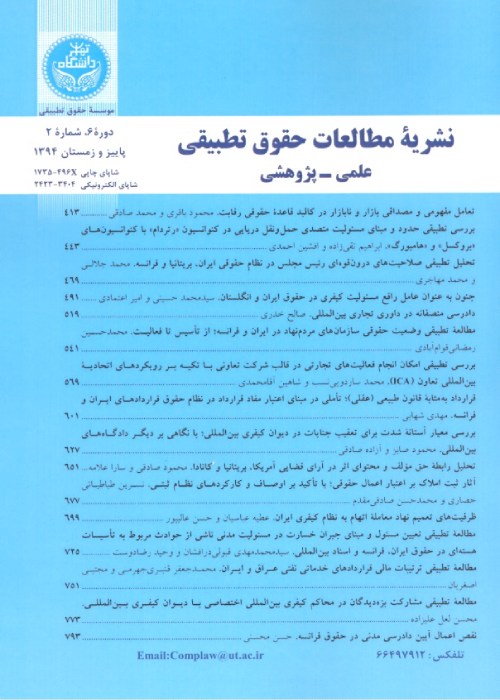Assessing Nuclear Liability Systems of Japan and the United States of America
Author(s):
Article Type:
Research/Original Article (دارای رتبه معتبر)
Abstract:
One of the nightmares of humanity in the current century is an occurrence of a nuclear incident. Nuclear incidents depending on the type of nuclear facility and material could have devastating damages. Following to nature and power of nuclear energy, any nuclear incident could impact a large area for a long-term period. Nuclear damages have a variety ranges from environmental pollution to the death of a large group of people. To confront it, initially, we should prevent to occur of these hazardous incidents and then fully prepare to deal with victims of nuclear incidents. In this way, a rapid, timely, and efficient system of compensation is vital. Regarding the scope of nuclear damages, it is necessary to draw a compatible liability model of compensation. In this way, nuclear liability was created in the early 1960s. This sort of liability is a new legal topic that attempts to create a proper system to compensate such victims. However, the international nuclear liability model has been changed several times to date. The occurrence of nuclear incidents especially the Chernobyl disaster in 1986 led to a revolution in the civil liability system for nuclear damages. This incident has expressed shortcomings and gaps in compensation when many people have entitled to a nuclear incident and need to prompt and sufficient compensation. This issue does not only include international law but also encompasses national laws. Thus, following nuclear incidents, national legislations have also been updated. Among them are the United States of America and Japan. These legal systems have experienced two severe nuclear incidents. The Three Mile Island and Fukushima Daiichi incidents, which occurred in the United States and Japan in 1979 and 2011 respectively, are among the most important nuclear events so far. Following the Three Mile Island and Fukushima Daiichi incidents, Either Japan and the United States of America have updated the nuclear liability systems. Therefore, the purpose was to develop the scope of liability of nuclear operators and to establish public funds to rapidly provide compensation to victims of nuclear incidents. Japan and the United States of America are considered two roughly appropriate civil liability for nuclear damages that supportive measures of victims of nuclear incidents are taken into account. Even in some aspects, these legal systems act better compare to international law. For instance, the legislature of Japan has established the nuclear liability model that does not have an upper limit. This issue causes to lift any limitation on the compensation of victims of nuclear incidents. The United States of America has also taken proper measures to compensate victims of nuclear incidents. Among the measures is to provide two tiers of compensation. The aim of this compensation scheme is to take assurance of an efficient compensation of victims resulting from a nuclear incident. As earlier mentioned, the occurrence of nuclear incidents could clearly demonstrate shortcomings and gaps in a legal regime of nuclear compensation. It is better to say, one of the most important effects of the tangible experience of nuclear incidents and their compensations is to evaluate and test the civil liability system resulting from nuclear incidents. In other words, the occurrence of such incidents can better answer the question of whether the existing liability system has been compatible with the severity of such incidents and damages. It is clear that such analyzes and assessments could lead to the identification of a framework for a civil liability system compatible with nuclear damages in countries such as Iran, which are deprived of such systems. Such countries that have not yet experienced a nuclear incident have the opportunity to establish a compensation model with a minimum of shortcomings and gaps. However, this paper attempts to explore the legislative systems of Japan and the Federal of the United States of America and along with that to determine and evaluate the impact of the Three Mile Island and Fukushima Daiichi incidents on the nuclear civil liability system by relying on a descriptive-analytical study method in order to finally establish dimensions of the liability system compatible with the type and amount of nuclear damage (huge damage).
Keywords:
Language:
Persian
Published:
Comparative Law Review, Volume:12 Issue: 1, 2021
Pages:
331 to 349
https://magiran.com/p2309487
دانلود و مطالعه متن این مقاله با یکی از روشهای زیر امکان پذیر است:
اشتراک شخصی
با عضویت و پرداخت آنلاین حق اشتراک یکساله به مبلغ 1,390,000ريال میتوانید 70 عنوان مطلب دانلود کنید!
اشتراک سازمانی
به کتابخانه دانشگاه یا محل کار خود پیشنهاد کنید تا اشتراک سازمانی این پایگاه را برای دسترسی نامحدود همه کاربران به متن مطالب تهیه نمایند!
توجه!
- حق عضویت دریافتی صرف حمایت از نشریات عضو و نگهداری، تکمیل و توسعه مگیران میشود.
- پرداخت حق اشتراک و دانلود مقالات اجازه بازنشر آن در سایر رسانههای چاپی و دیجیتال را به کاربر نمیدهد.
In order to view content subscription is required
Personal subscription
Subscribe magiran.com for 70 € euros via PayPal and download 70 articles during a year.
Organization subscription
Please contact us to subscribe your university or library for unlimited access!


